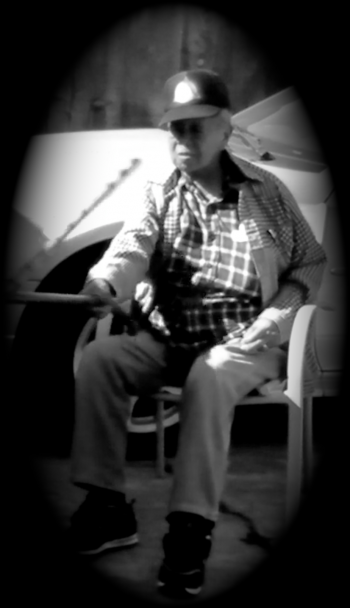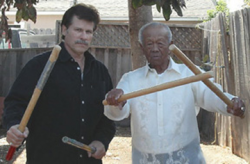Isidro P. Javier

Name: Isidro P. Javier
aka: Sonny Javier
Birth Name: Isidro Peneda Javier
Birth Place: Tagudin, Philippines - 1912
Martial Arts Practiced: Eskrima - Javier's Family Fighting Art
Rank: Honorable Great Grand Master
Occupation: Teacher, Fisherman, Farmer
Notable Student: Sr. Grand Master Frank Landers
Spouse: Raymunda Javier
HomePage: Isidro P. Javier
Isidro P. Javier (May 10, 1912 - August 18, 2010) was a Pioneering Filipino Eskrimador, WWII Hero, Organizer, Teacher, Author, Fisherman and Humble Farmer.
Contents
Stockton Memorial
On October 2, 2010 the Stockton Memorial Event was held before 250 celebrating at the Lexington Plaza Waterfront Hotel in Stockton California, honoring the lives of Manong Isidro P. Javier and Manong Leo Giron. In attendances were some of the most distinguish members of the Filipino Martial Artist Community representing there systems, their honoring two great men.
Bahala Na Multi-Style - said it best in a post released upon the passing of Manong Isidro P. Javier
"Last night the FMA community lost of one it's greatest warriors, Great Grand Master Isidro Javier.
He is one of the last of the World War II era Escrimadors. He was from a time when skill and ability in battle was
~ Bahala Na Multi-Style
the measure of an Escrimador, not a piece of paper or title. As with many from his generation, who participated in actual
life and death battles, he was a humble and honorable man. We, Bahala Na Multi-Style, were blessed to have met and spent
such great times with a true hero of the Filipino Martial Arts. Times we will cherish forever. Manong Javier, we miss you and
memories of you will remain in our hearts forever. May God guide you on your new journey and continue to bless you and your family".
Read more Tribute Postings
Personal Life
Born Isidro Peneda Javier (May 10th 1912)
Father: Saturnino Javier (1882 - unknown)
Mother: Benilda Javier (1880 - unknown)
First wife: Helen Dominguez
Second wife: Barbara Javier
Third wife: Raymunda Javier
Children: Donald Javier, Catherine Javier
Biography
By Glen Rathbone
Isidro P. Javier began his life’s journey in Tagudin, the Philippines, May 10, 1912.
Life in the “Barrios” or Barangays of the city found families and clans bundled together in closely guarded camps, each with their own dialects, rules, and protection. Competition often turned to violence as each Barrio jealously guarded its territory. Isidro Javier learned to be his own master in the toughest school of all; real life and death combat in the streets, grooming him as a leader and preparing him for the challenges he would face.
Isidro’s father was a fisherman and maker of nets, done by hand, a craft that was handed down generation after generation. And so was the ancient and secretive art of Eskrima and the Bolo Knife, known in the western world as Filipino Stick and Knife Fighting. Fathers taught their sons how to make weapons from the simplest of tools, and as a boy, young Isidro practiced his family art in the streets with his friends and ultimately, against his enemies.
In an interview recently, Mr. Javier described himself as a “troublemaker”, and recounted how he was the leader of his gang of six boys. The gangs clustered in small groups for protection and the constant give and take of power and territory. The boys practiced Eskrima and the Bolo Knife every day, perfecting their techniques, mastering new moves, always in the quest to top the competition.
There were no Dojos, no nicely padded mats, helmets or body protection. They simply whacked each other black and blue with the sticks, which easily raised lumps and bruises, but Isidro Javier decided the knife was his weapon of choice.
They would wrap their wrists with shirts or cloth and slice at each other in whirling, flashing moves. The result often meant cuts and slashes on the wrists and arms, but then, “the girls come and dress the wounds” Sometimes there was no time to wrap the wrists,” meaning if a fight broke out with another gang; they would go at it with no protection at all. Mr. Javier bears the numerous scars on his wrists from real street combat.
To be a gang leader, one had to show absolute fearlessness, total confidence and be the best with stick and knife. Isidro Javier was all of that. “Fight because of girls. When I say I want that girl no touch that girl. No good to fight if no encouragement (from the girls)." But the fighting became so dangerous that the local Priest intervened and forced the boys to swear not to fight. Mr. Javier smiles and doesn’t reveal whether the fighting really stopped.
For many boys of Tagudin, the only life was what they made in the streets, but for Isidro Javier this would never be enough. His keen mind and restless spirit could not be confined to the world he was born into. When he was only thirteen years old he borrowed a friend’s driver’s license, lied about his age, and bought the Cidual Tax required for anyone who wanted to leave the Philippines. He sailed to the big island of Hawaii and went to work on the sugar plantations, then to the other islands to harvest Pineapple. But opportunity soon knocked when his older brother Manuel Javier bought his plane ticket and brought him to Pismo Beach, California.
Isidro was the only one in the family who went to high school, and Manuel needed a bookkeeper to run his sugar pea farm. But war came to America and to Isidro’s homeland when the Japanese launched their master plan of Busido (Divine Right), and soon, the Draft landed him in the US Navy on an aircraft carrier in 1943.
Isidro was one of only four men assigned to fuel the aircraft on ship, and during combat he manned a machine gun as Japanese torpedo and Kamikaze planes attacked. His ship, USS Nehenta-Bay (CVE-74) sailed and battled in the South Pacific, but survived un-damaged through several campaigns. Isidro Javier earned his medals and his U.S. Citizenship, and returned as a hero.
* Victory Medal WWII - Silver Star
* Asia-Pacific Campaign Award - Silver Star
* Philippine Liberation Award – Star
However, Isidro Javier’s inner drive would not allow him to remain under his brother’s wings for long. Over the years he became a driving force that helped shape the Filipino community. He farmed, fished, and raised and trained prized roosters, which was a popular pass-time of the community.
On July 23, 1946 he earned the all-time record fish catch in Pismo Beach when he landed twenty-three thousand pounds of fish in one day.
He bought farmland all around the Central Coast of California and his status as a leader in the Filipino Community grew.
In the 1960’s the Farm Labor Movement brought Caesar Chavez to “Manong” (Godfather) Isidro Javier’s home, which became headquarters for the farm laborers as they fought for better pay and work conditions. Manong Javier worked side-by-side with Caesar Chavez as his main organizer. "I told them (workers) what to do, and they did it. I made things happen".
Numerous awards including his advancement to 33rd Degree Grand Master in the Masons, mark Isidro Javier’s many accomplishments.
His long journey of 98 years can be traced through a life of proper nutrition and diet. Mr. Javier was a master cook with some highly sought after secret recipes, but only he knew the ingredients.
Great Grand Master Isidro P. Javier passed away on August 18, 2010, having lived a truly remarkable life filled with challenges, starting in the streets of Tagudin as an Eskrima master fighter, to his many accomplishments as WWII hero, businessman, fisherman, landowner, and leader of his community.
Isidro Javier served on the USS Nehenta Bay (CVE-74) from 1943 - 1945.
Javier is an Philipine/American WW II hero that served Honorably in the US Navy to help liberate his birth home of the Philipines and was discharged in 1945.
Javier was awarded the:
Victory Medal WW II - Silver Star
Asia - Pacific Campaign Award - Silver Star
Philippine Liberation Award - Star
The Family Fighting Art - Eskrima
The Javier Method is a secretive and traditional family fighting art, based on the Filipino Martial Art System called Eskrima, and passed from father to son, generation to generation.
Isidro P. Javier began his training at the age of six, (1918) in Tagudin, Philippines and was taught by his father Saturnino Javier. By the age of twelve, young Javier was running his own gang in the Barrio of Ilocos Sur.
Javier's "Boys" and fellow gang members learned from their fathers' family traditions, and shared their knowledge with each other in different training methods, giving Isidro Javier an advantage over his adversaries in battle. As the result of many street battles with rival gangs, and through his later years of experiences, Isidro Javier has developed his own Multi-Style of Fighting that has been tested time and time again.
Manong Javier's only student is his son-in-law Frank Landers, who is Grand Master and founder of Seishindo Kenpo. On June 3rd 2010, GGM Javier named Grand Master Frank Landers as his successor and Senior Grand Master of the Javier's Family Fighting Art.
On July 17, 2010, Great Grand Master Javier adopted the Bahala Na Multi-Style as his family, and promoted Dexter Labonog to Grand Master of the Eskrima Art, sanctioned and endorsed by the Filipino Martial Arts Multi-Style Origination. Executive Committee: Great Grand Master Isidro P. Javier, Senior Grand Master Frank Landers, and Professor Catherine Landers.
As GGM Isidro P. Javier approached his 100th birthday, he recognizes that the world had changed from his early days of survival on the dangers streets Tagudin. He sees that there is no longer the need for secrecy in protecting his family fighting art treasures. He now wishes to preserve the family legacy by sharing his experiences and his family fighting art with the new generation of Eskrimador's now promoting Filipino Martial art's in America.
Fishing
Isidro Javier retired from fishing in 2002, still holding the position of "Biggest fish catch" in Pismo Beach, California July 23, 1946.
References
- Isidro P. Javier: (Landers, Frank (1985). Frank Landers Seishindo Kenpo, vol.3: Encyclopedia of Knowledge, FACTA Publications)..
- Biography: (Rathbone, Glen (2010). Isidro P. Javier Biography. The Rathbone Blog
- Video of Dexter Labonog Promotion
- Appointment of Grandmaster Dexter Labonog: (Rathbone, Glen (2010) The Rathbone Blog.


